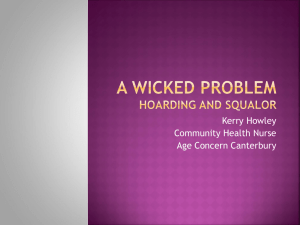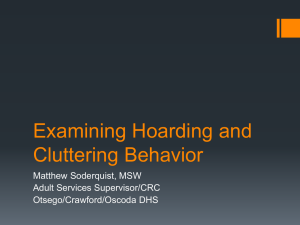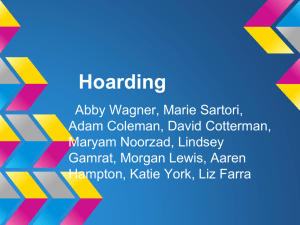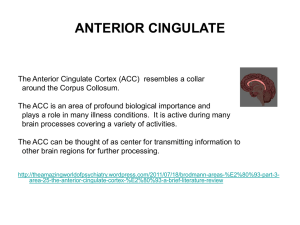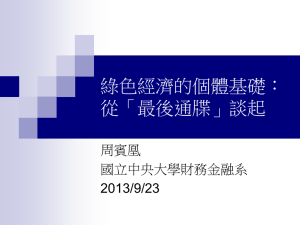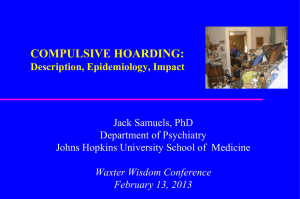Cerebral Glucose Metabolism in Obsessive
advertisement
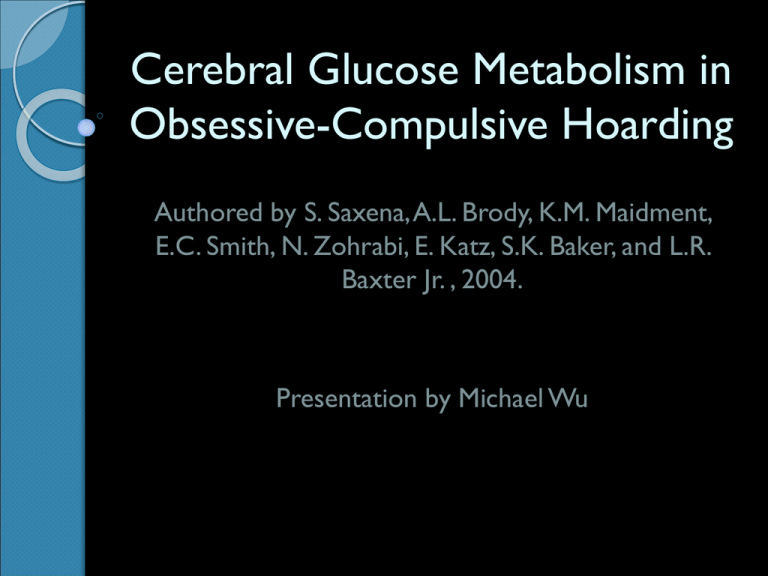
Cerebral Glucose Metabolism in Obsessive-Compulsive Hoarding Authored by S. Saxena, A.L. Brody, K.M. Maidment, E.C. Smith, N. Zohrabi, E. Katz, S.K. Baker, and L.R. Baxter Jr. , 2004. Presentation by Michael Wu Introduction Obsessive-Compulsive Disorder (OCD): ◦ A mental disorder that covers a wide range of symptoms, including: Aggressive/sexual/religious obsessions; Symmetrical/organizational obsessions; Contamination obsessions; Hoarding/saving/collecting obsessions. ◦ Often treated with SSRIs or cognitive behavioural therapy, but these treatments have been met with poor success when directed towards hoarding. Introduction Compulsive Hoarding: ◦ The accumulation and inability to discard worthless items. ◦ Also observed in schizophrenia, dementia, eating disorders, autism, mental retardation, and also in normal populations. ◦ Most common in OCD patients. Introduction • Animal studies suggest that hoarding may be mediated by the ventromedial striatum, globus pallidus, and medial dorsal thalamus, which are all structures linked to human OCD. • Electrical stimulation and lesioning studies also show that the anterior cingulate gyrus, hypothalamus, hippocampus, and the septum play mediation roles of hoarding in rodents. Drugs also affect hoarding symptoms. • In normal subjects, the provocation of hoarding-related anxiety activates the ventral prefrontal regions and the left amygdala, but the reason behind this is unknown. Methods A total of 62 subjects were studied: ◦ 45 with OCD (as diagnosed by the DSM-IV), 17 without. ◦ Of the 45 patients, 12 had compulsive-hoarding as the most prominent symptom of their OCD. ◦ The patients with hoarding symptoms were significantly older than those without. Level of activity defined as the level of glucose metabolized within a certain brain area. No cognitive task was given during the scanning. Methods MRI-based region-of-interest analysis was conducted, targeting broad areas that were associated with OCD and compulsive-hoarding from past research. The areas were the: ◦ ◦ ◦ ◦ ◦ ◦ ◦ ◦ ◦ Dorsolateral prefrontal cortex; Ventrolateral prefrontal cortex; Orbitofrontal cortex; Dorsal anterior cingulate gyrus; Ventral anterior cingulate gyrus; Caudate; Thalamus; Amygdala; Hippocampus. To narrow down smaller areas, another technique called statistical parametric mapping (SPM) was used. Methods MRI scans were taken first (region-ofinterest analysis), then PET scans were taken (SPM). 2 of the patients had invalid PET results, and were thus excluded from SPM. The activity shown on the brain regions were then superimposed onto the MRI images, producing the following results. Methods The scans were averaged for each group (OCD-with-hoarding, OCD-withouthoarding, normal). The images were then compared with each other, identifying areas with abnormal rates of glucose metabolism as areas of interest. Results Figure 1. Hoarders vs. Control Figure 2. Hoarders vs. Control A lower glucose metabolism was observed in the right posterior cingulate gyrus and the bilateral cuneus in hoarding patients. A higher glucose metabolism was observed in the left and right dorsolateral prefrontal cortices. Results Figure 3. Non-hoarders vs. Control A higher glucose metabolism was observed in the bilateral thalamus and the caudate in non-hoarding patients. Results Figure 4. Hoarders vs. Non-hoarders A lower rate of glucose metabolism was observed in the anterior cingulate Figure 5. Hoarders vs. Non-hoarders gyrus in hoarding patients. A higher glucose metabolism was observed in a small region in the right sensory motor cortex in non-hoarding patients. Discussion In all the patients, symptoms of compulsivehoarding may be due to lowered activity in the cingulate cortex, as shown by altered activity in the dorsal anterior cingulate gyrus. The functions of the dorsal anterior cingulate gyrus include motivation, executive control, focused attention, emotional connections to stimuli, emotional selfcontrol, problem solving, error detection, and selecting responses. Discussion Lower activity levels were found in the posterior cingulate cortex and cuneus in hoarders compared to control samples. The posterior cingulate cortex is responsible for monitoring visual events, episodic memory, emotional processing, and spatial orientation. Discussion The anterior and posterior cingulate gyrus have been linked to low activity, even after antidepressant treatment. This could mean that it is not the symptoms of hoarding are hard to treat, but that the activity in the cingulate gyri actually mediate the responses of the symptoms to the treatment. Discussion Occipital cortex deficits in hoarders were consistent with past research. ◦ Past research also found decreased grey matter density in these regions. This is linked to deficits in visuospatial processing and visual memories, which is observed in some OCD patients. ◦ Based on this imaging study, these deficits may be found primarily in hoarding patients. Conclusion The severity of hoarding was found to be negatively correlated with the activity in the dorsal anterior cingulate gyrus and posterior cingulate gyrus. Summary of brain activity variations: ◦ In hoarders: Lower posterior cingulate gyrus and cuneus activity; Lower dorsal anterior cingulate gyrus activity compared to nonhoarders; ◦ In non-hoarders: Higher thalamus and caudate activity; Significantly different neural patterns exist between the three groups, and the symptom of compulsive-hoarding is believed to be associated with suppressed activity in the cingulate cortex. Strengths and Weaknesses Strengths: ◦ Large sample size. ◦ Multiple imaging and analytical parameters (MRI combined with PET to accurately identify regions of interest.) Weaknesses: ◦ No cognitive task given, cognitive subtraction between groups only. No individual baseline to compare to. ◦ Why not fMRI and measure BOLD signal? ◦ Average ages not stated, only that hoarders were much older than non-hoarders and control samples. ◦ No graphs provided, only brain images. What Next? Research on lesioned OCD patients and the effects of damage to the dorsal anterior cingulate gyrus? ◦ One would expect that hoarding would get worse. Study patients that have undergone cingulotomies? Investigate whether hoarding associated with other mental disorders also follow this pattern of neural activation? Future Applications? Development of medication that raises activity in cingulate cortex to treat compulsive-hoarding? (eg. Amphetamines directed towards cingulate cortex.) New behavioural therapy approaches? (eg. Psychotherapy directed towards emotions and behaviour rather than Exposure and Response Prevention.) References Saxena, S., Brody, A.L., Maidment, K.M., Smith, E.C., Zohrabi, N., Katz, E., Baker, S.K., & Baxter Jr., L.R. (2004). Cerebral Glucose Metabolism in Obsessive-Compulsive hoarding. American Journal of Psychiatry, 161, 1038-1048. Questions? Summary Objective: ◦ Compulsive hoarding has been observed in OCD patients. PET scans were conducted to identify metabolic patterns in the brain associated with hoarding. Methods: ◦ Radiolabeled fluorodeoxyglucose PET scans were conducted on 45 adult OCD patients. Control measures were 17 healthy patients. Results: ◦ Patients with hoarding had significantly lower glucose metabolism in the posterior cingulate gyrus and cuneus, while non-hoarding patients had significantly higher glucose metabolism in the bilateral thalamus and caudate. ◦ Compared to non-hoarding OCD patients, hoarders had significantly lower metabolism in the dorsal anterior cingulate gyrus. ◦ The lower the metabolism was in the dorsal anterior cingulate gyrus, the more severe the hoarding. Conclusions: ◦ OCD patients with compulsive hoarding had different cerebral glucose metabolism patterns than control subjects or non-hoarding subjects. ◦ Obsessive-compulsive hoarding could be considered as a variant of OCD, where the symptoms are mediated by suppressed activity in the cingulate cortex.
